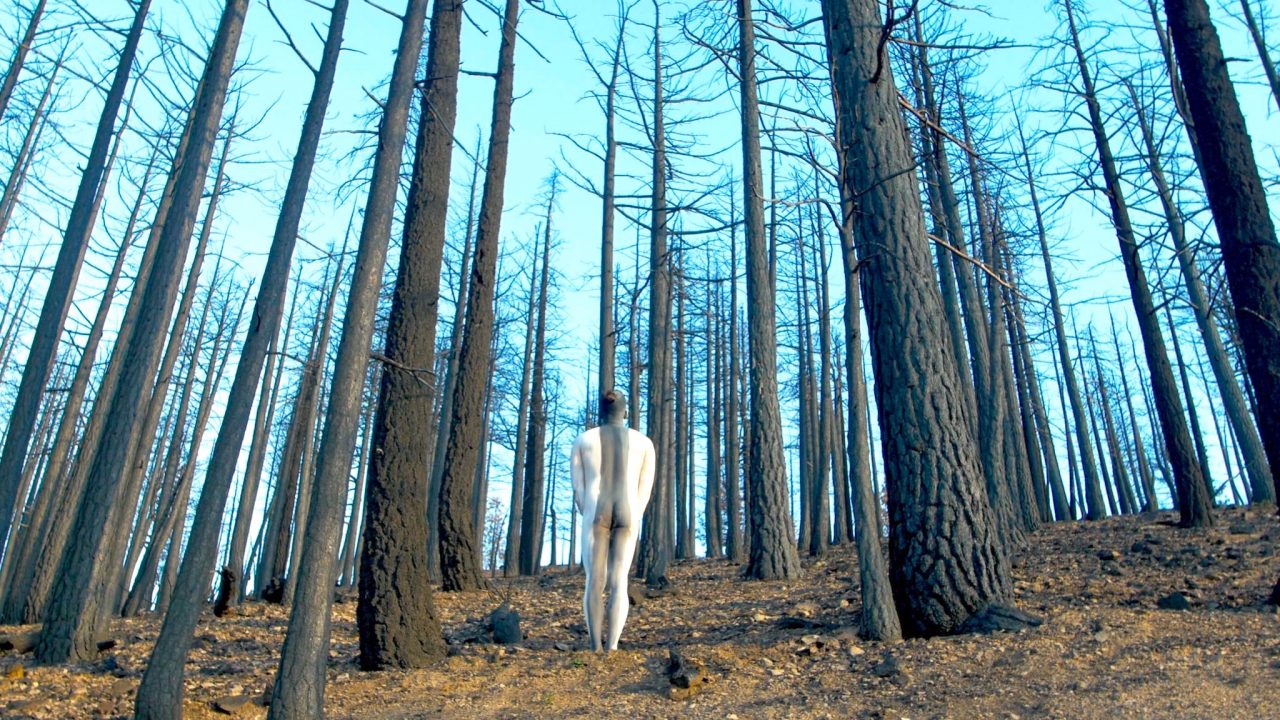The Devil at Your Heels: Is this for real?
The Devil at Your Heels, Robert Fortier, provided by the National Film Board of Canada
How can I best describe The Devil at Your Heels? Truth is stranger than fiction? The eccentric shall inherit the earth? Build it and they will come?
No, I had better just describe it as stuntman Ken Carter’s attempt to jump over a river – a distance of one mile – using a rocket-powered car. Yes, you read that correctly: A rocket-powered car!
He attempts to jump over the Saint Lawrence River from Canada to the USA in the area near Morrisburg, Ontario. Since this is a car we are talking about, he can’t land it on the other side. He has to crash it. Hmm, I’m not sure if this is the smartest stunt ever conceived.
The film shows two sides of Carter: the business man and the showman. We see him early in his career as he tours the country with his stuntmen jumping over parked cars and generally dazzling the crowds. The film explains that as he got older he dreamed of a final incredible stunt that would make him the greatest stuntman alive.
Shot over 5 years, The Devil at Your Heels documents Carter’s efforts to secure financing, time and time again, to build a hundred-foot ramp and a rocket car capable of jumping that distance. It is safe to say that everything that could go wrong went wrong, including the car’s fuel tanks exploding several times.
The engineers who build the fuel tanks are onscreen often, trying to explain that they will get these problems worked out. It is hilarious to see how their determination changes with every setback. When things are going as wrong as they possibly can, the engineers start to wonder if God is trying to tell them something.
Throughout the numerous setbacks (trust me, there are too many to count) Carter’s enthusiasm never falters. He is convinced that he can make this jump happen (and become the world’s greatest stuntman in the process), even when all the odds are against him.
Speaking of great stuntmen, Evel Knievel comes by the jump site to report for ABC Sports (who will show the jump live) and discovers that the ramp is about half built and pretty much nothing will be ready on time due to the omnipresent rain. Carter’s expression is priceless as he tries to reassure Knievel that everything is progressing as it should even though it is obvious to everyone else that there is no way the jump will go ahead as scheduled.
The film was originally intended as a short on the jump attempt in 1975. Filmmaker Robert Fortier thought it would all take place over a couple of weeks, and he would get some great stunt footage. As things dragged on, he had to alter his plans and ask the NFB to allow additional shooting. The result is a fascinating feature documentary on Carter the man and Carter the promoter.
One newspaper review pointed out that Carter rarely spends his own money and is a master at getting others to open their wallets. I don’t know if I would go that far, but I will acknowledge that he certainly knows how to sell a dream.
Now I’m sure most of you want to know if Carter succeeds in making the jump. I won’t reveal what happens at the end but it includes a surprise twist you never see coming. The film moves at a surprising clip, and you rarely notice the 102-minute running time.
Gordon Pinsent does a masterful job narrating with wry humour. The filmmakers never make fun of Carter. He is always treated with respect even though some of the situations he finds himself in are downright hilarious. Sometimes it’s like watching a train wreck: It is horrible to look at but you can’t keep your eyes off the action.
The film was completed in 1981 and shown to various theatrical distributors in the USA who found it “too documentary.” In Canada, the distributors found it too long. Documentary features were not in vogue in the 1980s so the NFB gave it a scattered release in several cities. It played, notably, in Montreal as well as at a Calgary Cineplex for a week in March 1982.
The film picked up the Genie for Best Theatrical Documentary in 1983. It did much better on television airing throughout the world in countries such as Italy, the Netherlands, the USA, Norway, Argentina and Israel. It was very popular on home video and became a cult hit in Australia.
Sadly, Carter was killed in September 1983 when the rocket-powered car he was driving overshot a ramp by 30 metres and crashed during a stunt show in Peterborough. He was only 45, but he lived every one of those years as fully as any human being can.




Pieces of the car survive in nearby Ingleside, Ontario. Including the roof hatch and even the passenger side wing! I would like to find the rolling chassis of Ken Carter’s lincoln they pulled from the water. Word has it it was scrapped in Montreal, another said it was stolen from storage in Iroquois Ontario.
If anyone has any info or is a fan of the Ken Carter – Morrisburg Superjump story, look us up at Facebook.com/themadcanadian
Thanks again.
Wow, what a ramp ! Cool to see Evel Kniever jealous ! Ironic that they used his stand-in ,almost as if scripted! Really sad that he lies in an unmarked grave , I would like to start somekind of charity/collection to place a tombstone, a great tombstone stating both his names and “The greatest stuntman that ever lived” as well a a depicture of a square box car flying between two ramps!
I’m looking to get in contact with Robert Fortier regarding this film and his interactions with Ken Carter and the whole project. If anyone has any leads it would be greatly appreciated. I also have a few items from the story, thought to be lost that Mr. Fortier may appreciate hearing about. I am in the Ottawa-Montreal area and would really like just a few minutes of his time, be it over the phone or through email correspondence. Thanks for reading.
Cody
c.glive@live.com
As one of those people that assisted in making this film a “cult hit in Australia”, let me say that in my opinion this is a great doco. I’ve watched it many times (hey, it’s a cult hit here in Aus) and never grow tired of it.
Some years ago, I had the oportunity to travel to the US, so I decided to go the extra step and head up to Canada, to visit Morrisburg, Ontario to see what I could see.
Morrisburg is a pretty little town, with the emphasis on little. The first thing I did, was to seek out the field where the ramp was constructed. The elevated section of the ramp was long gone, but parts of the paved approach track are still there (I drove my rental car on it – don’t tell the rental company). The second thing I did was to locate the local library, to find out how the locals remembered the ‘super jump”.
The locals do not have fond memories of Ken Carter. He promised them the world and (according to them) left the town, owing thousands in unpaid bills to local businesses. As far as I could find, the only local business that was paid in full was Cruickshank Constructions, the company that supplied the excavation equipment to construct the ramp. I spoke to the owner, Les Cruickshank, who told me that he simply refused to do anymore work unless he was paid every Friday. No money on Friday, no work on Monday. Later on in my trip, I went to Los Angeles, to visit Jim Deist of Deist Safety Equipment. Jim Deist supplied the parachutes and safety harnesses for the rocket car. When I introduced myself to Jim and told him I’d like to ask about Ken Carter, the first thing he said to me was, “that bastard still owes me $30,000!” For the record, Jim knew that Ken was dead and he wasn’t getting his money.
You’ll notice in the doco, that part way through, Ken Carter is sporting a goatee after being clean shaved at the start. You’ll also notice another stunt driver that appears in later in the film called Ken Powers. He also has a goatee. The thing is, as stated in the film, Ken Carter is frequently injured, but, so the stunts he is booked for at local carnivals can go ahead, Ken Powers regularly substituted for Carter. Carter would appear at the show, then retire to his trailer to ‘prepare’ and Powers would emerge, wearing a racing suit, helmet and sunglasses/goggles – you couldn’t tell them apart.
2013 will be the 30th anniversary of the passing of Ken Carter, the Mad Canadian. He should be remembered and his contribution should be acknowledged…
Thanks for the extra insight into Ken Carter; it confirms somewhat my impression of him from the film, reading between the lines – but wow, what a character, what a showman. I was saddened to hear he was killed – its extraordinary how makeshift all those stunts were back then. I was also intrigued to find Ken Powers drove stunts in Vanishing Point and Smokey and the Bandit.